In the most ancient of days, before words, human beings communicated with the things of nature. Flowers, steeped as they are in symbolism, continue to be our messengers. They speak of love, gratitude, forgiveness and remembrance. Various cultures attach meaning to certain blossoms, which can convey honour and respect, passion, broken trust and even fertility. Flowers speak to us with colour, fragrance and complexity of form. Here are a few favourites.
Sunflower (Helianthus annus)
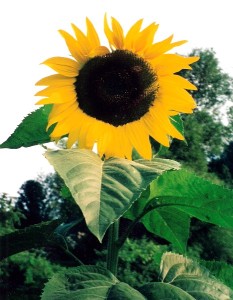 When you look at the muscular sunflower standing so tall in the field with its face continually turning to the sun, what is it saying to you? Every part of the sunflower is useful. The seeds are edible, the stalks make wonderful fodder for animals and its leaves can be used for cloth. To many, the unspoken words of a sunflower say, I give, I am useful. My loyalty is unwavering.
When you look at the muscular sunflower standing so tall in the field with its face continually turning to the sun, what is it saying to you? Every part of the sunflower is useful. The seeds are edible, the stalks make wonderful fodder for animals and its leaves can be used for cloth. To many, the unspoken words of a sunflower say, I give, I am useful. My loyalty is unwavering.
To the Incas who lived in the Andes Mountains on the western coast of South America, the sunflower speaks of power, warmth and nourishment—all attributes the sun itself expresses. The Incas revered the sunflower so much, they hammered images of the blossom into gold pieces and put them in prominent places in the temple. In Chinese traditions, the sunflower symbolizes longevity.
Aster (Aster)
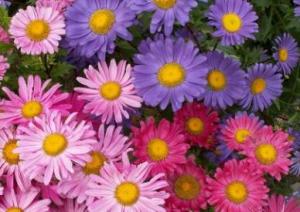 Long ago legends speak of the goddess Virgo taking stardust from the heavens and scattering it upon the earth. Where each grain of stardust fell, an Aster grew. In Greek, the name aster means star, and the night sky is what people think of when they see clusters of this daisy like flower.
Long ago legends speak of the goddess Virgo taking stardust from the heavens and scattering it upon the earth. Where each grain of stardust fell, an Aster grew. In Greek, the name aster means star, and the night sky is what people think of when they see clusters of this daisy like flower.
The aster is thought to have magical powers to Europeans. Lore says the yellow eyes in the centre of the flower can drive evil spirits away.
Hyacinth (Hyacinthus)
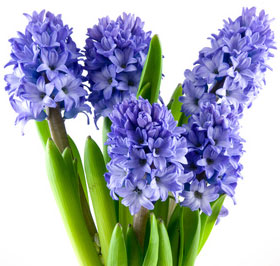 Nothing says young and fragile like hyacinth blossoms. They bloom early and are quickly gone. According to the French flower code, hyacinth says, you love me and destroy me.
Nothing says young and fragile like hyacinth blossoms. They bloom early and are quickly gone. According to the French flower code, hyacinth says, you love me and destroy me.
Greek legend says the gods Apollo and Zephyr were both in love with a beautiful mortal youth named Hyacinth. Zephyr killed the youth when he discovered Hyacinth preferred Apollo to him. The flower speaks of consolation for lost love, for where his blood was spilled by Zephyr, Hyacinth blossoms sprang forth.
Daisy (Bellis Perennis)
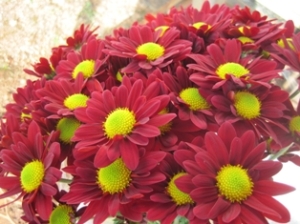 When you look at a bunch of daisies, innocence and purity seem to radiate outward in waves. The flower’s name comes from the Old English words, day’s eye, because of the daisy’s habit of shutting their petals (to cover their eyes) when the sun goes down.
When you look at a bunch of daisies, innocence and purity seem to radiate outward in waves. The flower’s name comes from the Old English words, day’s eye, because of the daisy’s habit of shutting their petals (to cover their eyes) when the sun goes down.
Ancient Greeks tell this story about the origins of the daisy. One morning a group of wood nymphs went to the edge of the forest to dance where the sunny orchard began. The god of the orchard drew near to watch, and became enamoured with one of the nymphs. But when he rushed in closer, the wood nymphs vanished from sight by becoming daisies growing at the edge of the forest.
Peony (Paeonia)
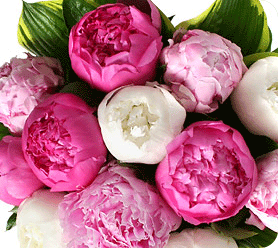 The peony stands for the steadfast power to keep a secret or a promise because of its very deep roots and ability to stay so firmly planted in the ground.
The peony stands for the steadfast power to keep a secret or a promise because of its very deep roots and ability to stay so firmly planted in the ground.
There is a story about a farmer who needed his horse to pull one from the ground because he was unable to get the plant out on his own. Therefore, it is said giving peonies, enhances a promise’s power. In Japan, where peonies have been cultivated for a thousand years, the peony symbolizes prosperity. Because they require careful cultivation, only the rich can afford them.
Tulip (Tulipa)
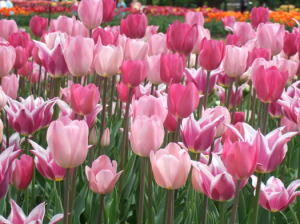 A red tulip is used to declare love in Persia. The tulip’s black center is said to represent the lover’s heart burnt to a crisp by the passion of love.
A red tulip is used to declare love in Persia. The tulip’s black center is said to represent the lover’s heart burnt to a crisp by the passion of love.
Tulips are native to Persia, but arrived in Europe in the fifteen hundreds when a traveller in Constantinople brought some home with him. The tulip was so popular in Holland and the bulbs fetched such high prices that speculation in tulip bulbs began which eventually brought about a collapse in the market. The entire country plunged into a depression from that point.
The word tulip is derived from the Turkish word for turban, for how the blossom resembles the shape of a turban.
Let the blossoms speak
The next time you send flowers, think about the sentiment you want to express to your loved one and let the blossoms communicate their ancient messages. Of course, it wouldn’t hurt to include some information on the power of flowers when you fill out the accompanying card!
